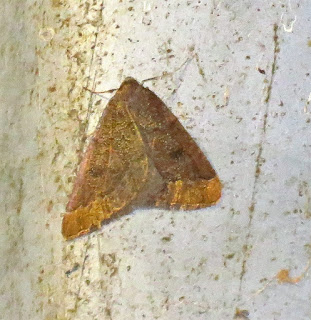Priorslee Lake: 06:45 – 09:20
The Flash: 09:25 – 10:15
10°C > 11°C: Scattered cloud below a high overcast. Moderate WSW wind. Very good visibility
Sunrise: 08:22 GMT still
Priorslee Lake: 06:45 – 09:20
(194th visit of the year)
Bird notes
- more Black-headed Gulls than the last few days – due to stronger wind? Later they exhibited unusual behaviour circling very high overhead before drifting downwind off to the E. I think these had all started from the lake rather than birds from elsewhere but cannot be certain
- a lone Lapwing arrived on the SW grass at 08:15 and stayed until after 09:00 before being flushed by a dog-walker
- 4 Reed Buntings left the roost at 08:05; 4 more at 08:13. Neither group was heard to call before they left. Perhaps I missed some: these left to the S rather than to the E as they have done the previous few days. Due to the stronger wind?
Bird totals
Birds noted flying over or flying near the lake
- 1 (0♂) Goosander
- 3 Lesser Black-backed Gulls
- 8 Wood Pigeons
- c.200 Jackdaws
- 1 Rook
- 1 Raven
- 11 Fieldfare
- 1 Siskin
Birds recorded leaving roosts around the lake
- [Magpies not counted]
- 7 Redwing
- 8 Reed Buntings
The counts from the lake area:
- 2 Mute Swans
- 2 Greylag Geese again
- 12 Canada Geese
- 8 (4♂) Gadwall again
- 10 (6♂) Mallard
- 30 (15♂) Tufted Ducks
- 1 Cormorant again
- 2 Grey Herons
- 1 Little Grebe again
- 2 Great Crested Grebes still
- 8 Moorhens
- 72 Coots
- 1 Lapwing
- >200 Black-headed Gulls
My log of other things, all on lamp poles
- 3 Winter Moths
- 3 Mottled Umber moths
- 1 Early Moth: a different specimen
- 1 stretch spider, Tetragnatha sp. again
The ‘sunrise’ showing that it wasn’t quite the 100% cloud as forecast.
Here are the two ‘new’ Mute Swans. I think the cob is on the left with the larger ‘knob’ at the base of the bill. Note that his bill is much more orange-toned than the pen. I suspect she is not fully mature, though likely mature-enough to give nesting a go this year.
This is a rather strange moth with rufous-tinged wing-tips. As far as I can tell it is ‘just’ an extreme form of Early Moth.
(Ed Wilson)
------------------------------------------------------------------------------------------------------
The Flash: 09:25 – 10:15
(153rd visit of the year)
Bird notes from here
- the cygnet Mute Swan was seen taking a short flight this morning: the first time I have seen it well clear of the water
- a 2nd Great Crested Grebe this morning: birds often keeping together
- perhaps the number of fishermen was behind the dearth of Goosanders, though the new-in Pochard and small increase in the number of Tufted Ducks might suggest otherwise
- a Nuthatch apparently inspecting its nest site
and
- checked the Ivy again as it was mild and bright: only a single Muscid fly noted (perhaps Eudasyphora cyanella)
- fungus that might be Stereum hirsutum (or Hairy Curtain Crust) noted
Birds noted flying over / near The Flash
- 1 (0♂) Goosander
- 1 Sparrowhawk again
- 1 Raven
The counts from the water
- 2 + 1 Mute Swans
- 6 Canada Geese
- 49 (29♂) Mallard
- 1 (1♂) Pochard
- 28 (11♂) Tufted Ducks
- 3 (0♂) Goosanders
- 2 Great Crested Grebes
- 4 Moorhens
- 20 Coots
- 42 Black-headed Gulls
- 1 Lesser Black-backed Gull again
The pair(?) of Great Crested Grebes. The first time there have been two of this species here for several months.
The large bill and diamond-shaped tail mean this has to be a Raven.
In silhouette we see the characteristic shape of the large bill. Note also the ‘fingered’ wing-tip. Usually a Raven is obvious from its call, its tendency to turn upside down or its sheer size. My rule to separate from Crow is that if I have any doubt its a Crow. A Rook tends to be easy because of the distinctive pale and dagger-like bill.
The Nuthatch is certainly giving it good look.
Before doing its trapeze walk along one of the branches.
Perhaps it is safer across the branch.
This view shows something I have never seen before. Flies have very small hind wings (halteres) that apparently act like gyroscopes to maintain the fly’s balance when it is flying. We appear to be able to see these. I cannot really make out what is face and what is mouth between the eyes. Looks rather nasty anyway.
This fungus is growing on fallen wood. I think it might be Stereum hirsutum (or Hairy Curtain Crust): its is certainly hairy.
(Ed Wilson)
------------------------------------------------------------------------------------------------------
On this day..........
2012Priorslee Lake
Drake Scaup
2 Yellow-legged Gulls
3 Great Black-backed Gulls
(Martin Grant)
2011
Priorslee Lake
4 Yellow legged Gull
22 Great Black-backed Gulls
(John Isherwood)
Priorslee Flash
Tundra Bean Goose
(John Isherwood)
Holmer Lake
9 Goosander
(John Isherwood)
2009
Priorslee Lake
1 Black-necked Grebe
4 Gadwall
2 Water Rail
2 Caspian Gull
Yellow-legged Gull
Ring-billed Gull
(John Isherwood/Richard Vernon/Dawn Balmer/Peter Wilson)
2007
Priorslee Lake
1 Cormorant
3 Wigeon
30 Tufted Duck
4 Pochard
180+ Coot
3 Yellow-legged Gulls
4000+ Lesser Black-backed Gulls
65 Herring Gulls
1000+ Black-headed Gulls
(Martin Adlam)
2006
Priorslee lake
1 Little Grebe
3 Pochard
10 Tufted Ducks
1 Lapwing
>550 Black-headed Gulls
>108 Lesser Black-backed Gulls
1 Great Black-backed Gull
c.40 Redwings
(Ed Wilson)
2005
Priorslee lake
c.3200 Lesser black-backed Gulls
c.1700 Black-headed Gulls
c100 Herring Gulls
8 Great Black-backed Gulls
4 Yellow-legged Gull
(Martin Adlam/Ed Wilson/John Isherwood)












